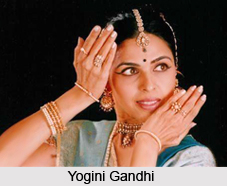 Kathak and Odissi both classical style of Indian dance has been performed with `equal dexterity and virtuosity` by Yogini Gandhi. A dancer of her own rank Yogini Gandhi wiyth her grace and natya redefines the style of Kathak and Odissi.
Kathak and Odissi both classical style of Indian dance has been performed with `equal dexterity and virtuosity` by Yogini Gandhi. A dancer of her own rank Yogini Gandhi wiyth her grace and natya redefines the style of Kathak and Odissi.
Yogini was admitted to Kala Chhaya after her introductory training in Kathak. At Kala Chhaya she has come under the umbrella of legendary maestro Pt. Birju Maharaj. Here she underwent valued guidance, which helped her to develop a unique style of her. Later on Yogini Gandhi under the great tutelage of Guru Natabar Maharana learnt another art form Odissi. Her large expressive eyes and elegant dancing posture well complemented with the performances that she executes both in the form of Kathak or Odissi. Today she has been counted amongst those distinct classical dancers who excelled in two distinct styles.
The name Yogini Gandhi has been regarded as the accumulation of `talent, intellect and beauty`. She possesses a strong command on the two most important aspects of dance, namely "Nritta" and "Nritya". These two aspects have been enhanced by her elegant stage presence. Yogini Gandhi incorporates an aesthetic approach and creative mind to her performances.
Acknowledging her talent, Yogini Gandhi has been honored with the title "Singar Mani". She has also conferred the award, "Outstanding Young Person" recognizing her contribution to the domain of dance. The Indian Council for Cultural Relations (I.C.C.R), New Delhi has also empanelled her and the Doordarshan Kendra included her as the graded Television artist. At the Lalit Kala Kendra, Pune University, Yogini Gandhi has also serves as one of a faculty member.
Yogini Gandhi has toured in an extensive manner Sweden, Denmark, Norway, Switzerland and England and mesmerized the audiences, art critics through her performances. She has staged both the dance form, Kathak and Odissi. She has also conducted several workshops and lecture demonstrations for many academic institution to spread the awareness among the people. With the aim of promoting and nurturing Indian classical music and dance forms, she has established `An institute for the Promotion of Indian Art and Culture`-Kalanidhi.
Apart from being a multifaceted dancer, Yogini Gandhi has also plunged into the domain of theatre and music. She has also bagged the honor of being attached with a Swedish Theatre Project. At the theatre she has playacted the lead role of a strong Indian Women. Yogini Gandhi through her career has come across many well-established dancing personalities.
Yogini Gandhi has also conducted several programmes to her credit that ranges from shows to corporate meets in English, Hindi, Marathi, Gujarati and Urdu. She made this possible with her natural flair for languages. Yogini has also made herself one of the most sought after compere.



















